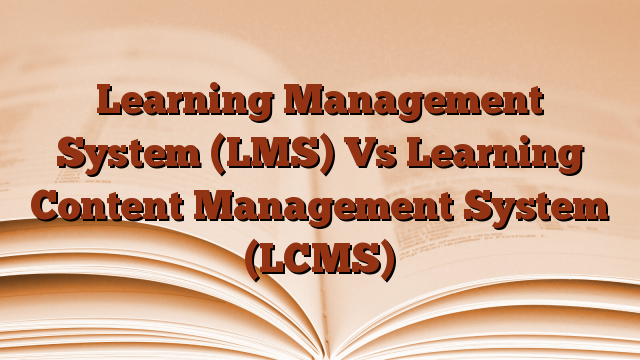E-learning provides an organization with learning options that are not only less expensive, but also more flexible than classroom training. In fact, while e-learning would never replace “a human touch” that classroom training is privileged to enjoy, current technologies enable the creation of e-courses that are relevant, engaging, participatory, and with “a fun element.” .
As more organizations adopt e-learning or blended learning (a combination of e-learning and classroom instruction), more organizations are faced with the question of which systems best fit their environment. Larger organizations are looking for systems that not only deliver and track e-courses, but also allow for the integration of performance reviews and development plans. The needs of smaller organizations may be more succinct and limited to the provision of training. So what do we consider when choosing the best e-learning program? Let’s look at the differences between the two main e-learning systems – Learning Management System (LMS) and Learning Management Content System (LMCS).
LMS is a software application, mostly web-based, designed for the administration, documentation, tracking, and reporting of e-learning programs and training content. LMS such as WestNet, Halogen, Flextraining or Mindflash require the import of content created externally using Microsoft programs or e-learning development software such as Adobe Captivate or Articulate. Many LMSs offer a monthly subscription for a fee based on the number of active users (trainees). Some LMS offer one-time licensing and charge annual fees for software upgrades and technical support, which can range from 10% to 25% of the license fee.
We know of at least 210 different LMSs with a range of features offered: from simple content delivery and reporting to sophisticated integration with learning management and social media platforms. Likewise, the difference in subscription and hosting fees is huge, ranging from $3,000 to over $23,000 per year for a thousand users.
In comparison, a Learning Content Management System (LCMS) is content-centric software for creating and managing e-learning content (Xyleme, Exact Learning Solutions, Kenexa). Instructional designers and trainers can reuse e-learning content. This saves resources and time for course development. Rather than re-creating entire courses, LCMS provides the ability to modify and publish courses to different audiences while preserving previous versions. E-training items that developers can manipulate include media files, assessment items, simulations, text, or graphics. LCMS technology can also be used to deliver and track courses (as an LMS) or as a standalone application for learning initiatives that require rapid development of learning content.
So the main difference is that LMS doesn’t allow creating and editing courses; It cannot reuse the content of one course to create another. However, the LCMS can not only create, manage and deliver training modules, but also manage and edit all the individual parts that make up training modules. LMCS subscription or license is usually more expensive than LMS.
So what does an organization need to consider when choosing the most appropriate e-learning system?
– A lot of training content to be developed and delivered. If an organization develops and delivers a large volume of training – either due to internal or external needs – then LMCS may be a better choice. LMCS will be able to save instructional designers’ time by reusing already created training content.
– Long-term training and development needs. When an organization plans to grow and expand, it means that training and development needs will also increase. Even if an LMS seems more suitable today, an LMCS can be the best solution in the long term. In this way, an organization avoids additional resources and confusion when moving from one system to another.
– Training audience. Larger organizations employing staff nationally or internationally would have a greater need for updated training modules – due to local regulations and cultural preferences. Therefore, LMCS could be beneficial in this case.
– The plans to integrate e-learning into organizational social platforms. A few LMS and LMCS enable the integration of organizational social platforms such as intranets or wikis. Although these systems tend to be more expensive, this emphasis on learning encourages workers to engage in more training and increases their engagement.
– The need to use e-learning systems for performance management. Select LMS and LCMS can perform performance management functions by allowing managers to track employee performance (including learning application outcomes from completed courses) and by allowing employees to create development plans based on performance reviews.
E-learning is a powerful learning platform. When an organization chooses “the right” system, such a system can not only save costs but also improve learner engagement and retention.
Thanks to Eivina Muniute-Cobb | #Learning #Management #System #LMS #Learning #Content #Management #System #LCMS

Leave a Reply